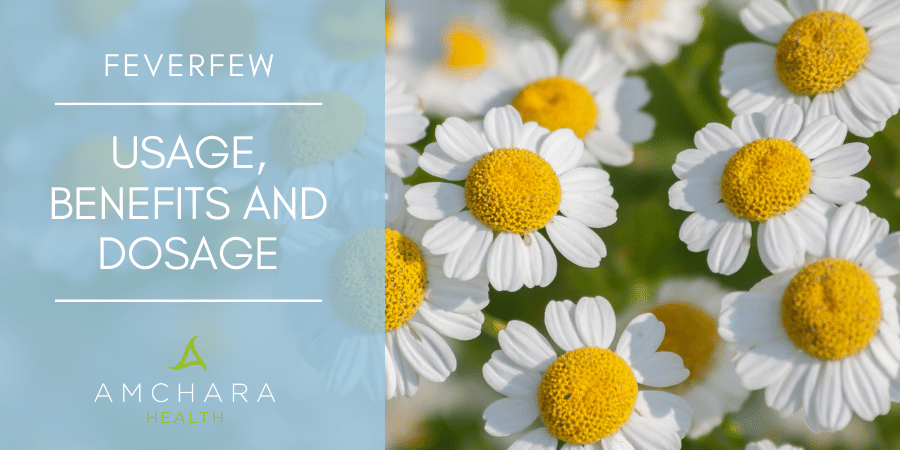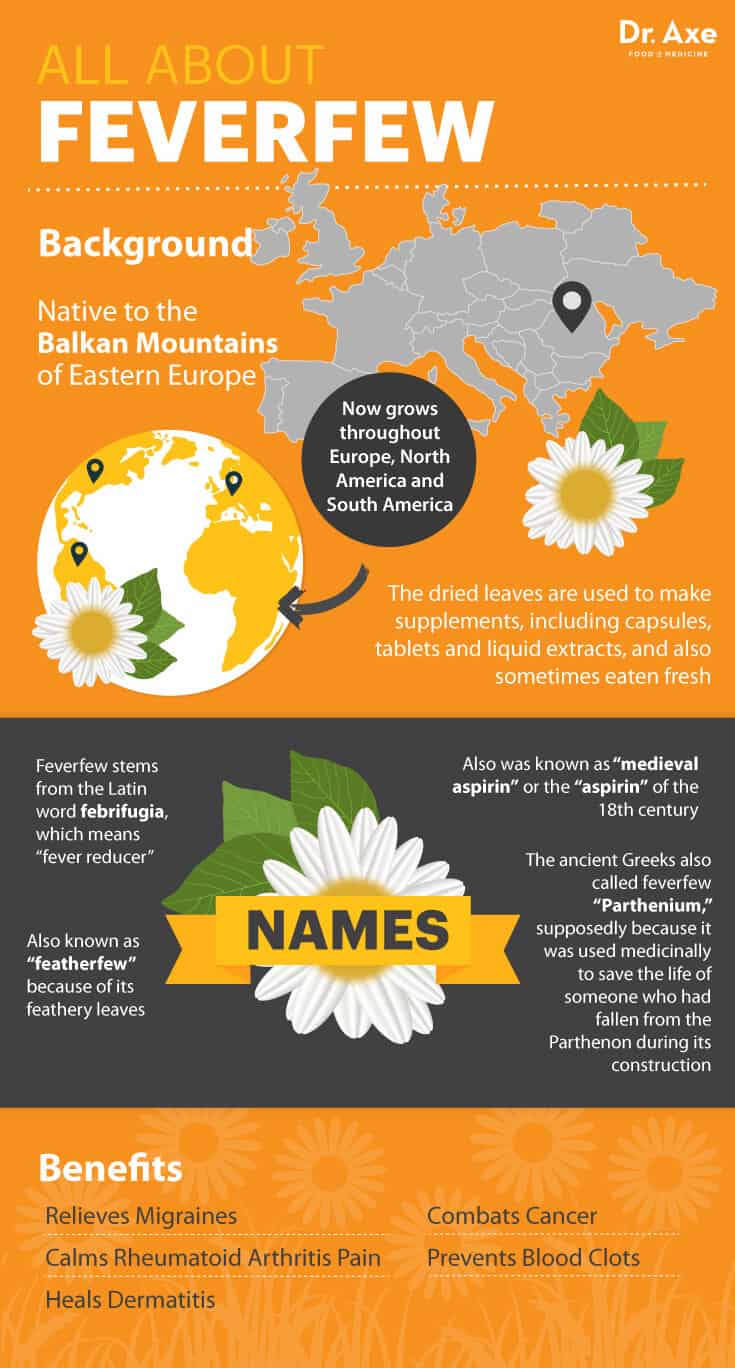Feverfew (Tanacetum Parthenium) is a yellow-green perennial plant native to southern Europe, but also found in old English gardens.
It has pretty daisy-like flowers characteristic of the Compositae family to which it belongs.
Feverfew originates from the Latin word febrigugia, which means fever reducer.
The plant has strongly scented leaves, which are the parts commonly used in herbal preparations.
Feverfew was once known as ‘medieval aspirin’ or the aspirin of the 18th century and was used to treat a whole host of ailments ranging from arthritis, to psoriasis, toothache, constipation and fevers.
One of the most interesting applications of Feverfew is in both the prevention and treatment of migraine.
It is the only herb used in European phytotherapy that is known to be specific for the treatment of migraine and due to positive results from numerous studies is gaining recognition by orthodox medicine for this purpose.
Migraine is a surprisingly common disorder affecting up to 20% of men and 30% of women.
It can be an extremely debilitating condition characterized by moderate to severe recurrent attacks which vary in intensity, duration and frequency.
These attacks are typically felt on just one side of the head and are often associated with vomiting, nausea and loss of appetite.
Many migraine sufferers have warning symptoms or ‘auras’ preceding or accompanying an attack which can last for a few minutes.
These include a range of symptoms such as numbness and tingling on one side of the body, visual disturbances, fatigue, disturbed thinking and anxiety.
Worldwide, migraines affect more than 10% of people.
Causes of Migraine
Migraine occurs as a result of inflammation to the blood vessels surrounding the brain.
Blood platelets in migraine sufferers have been seen to clump together more readily than in non-sufferers.
This can occur quite spontaneously but is also attributed to exposure to the neurotransmitter serotonin and catecholamines such as adrenalin.
When blood levels of catecholamines rise the body releases serotonin which is a potent vasoconstrictor.
This causes blood vessels to spasm and platelets to clump together.
The combined effects lead to an interruption of the blood flow to the brain.
A rebound mechanism quickly follows, resulting in a widening of the blood vessels and the release of pain inducing substances.
This cascade of events ultimately produces the symptoms associated with a migraine headache.
There are several factors that have been seen to contribute to migraines.
In women they are often linked with the menstrual cycle, originating around puberty and continuing until the menopause and also with the use of the birth control pill.
Migraine attacks have been attributed to abnormal sensitivity of the blood vessels in the cerebral circulation which disrupts blood flow to the cerebral cortex of the brain.
Several emotional and psychological stressors may trigger an attack such as stress, tension, pain, anxiety and fatigue.
Foods containing vasoactive amines are also common triggers e.g. chocolate, red wine, cheese, dairy products shellfish, coffee and citrus fruit.
Additionally weather, especially barometric pressure changes can trigger migraines.
There are many medicines available to prevent or reduce frequency of migraines however some of these drugs may give rise to unpleasant side effects.
Feverfew is a relatively safe and natural alternative.
Beneficial Actions of Feverfew
- Inhibits serotonin and prostaglandin release from platelets
- Reduces blood vessel constriction
- Inhibits platelet aggregation
- Inhibits formation and release of inflammatory substances
Feverfew appears to work to work at least in part by inhibiting platelet aggregation as well as release of serotonin from blood platelets and leucocytes.
The most important biologically active constituents of Feverfew are the Sesquiterpene lactones, in particular parthenolide which is found in the superficial leaf glands but not in the stems.
Parthenolide helps to control the expansion and contraction of blood vessels in the brain.
It is likely that these sesquiterpene lactones inhibit the release of prostaglandins and histamine during the inflammatory process, thus preventing the blood vessel spasms in the head that trigger migraine attacks.
Historical Use
Documentation suggests Feverfew has been used since antiquity to reduce fever and pain.
The ancient Greeks called the herb “Parthenium” – evidently because it was administered medicinally to save the life of someone who had fallen from the Parthenon during its construction in the 5th century BC.
There is also evidence to suggest that feverfew has been used throughout recorded medical history as a bitter tonic, a vasodilatory, a sedative, a digestive, a uterine stimulant and as a remedy for severe headaches.
Infusions of the leaves have proved effective for dizziness, asthma, catarrh, sinusitis and insomnia. It was also thought to help mild depression.
Other less supported claims for feverfew are that it relieves menstrual cramps and arthritic inflammation.
During the last decade it has been increasingly employed as a remedy for the prevention of migraines.
Safety and Efficacy
Data collected from a number of studies show that Feverfew is effective in preventing migraine attack, but only over a long period of time.
It should be taken for three months continuously in order to achieve maximum effects.
Trials suggest that Feverfew is generally well tolerated with mild and reversible adverse effects.
Feverfew should be avoided if an allergy to any plant members of the daisy family exists, if a clotting disorder exists, or during pregnancy.
Dosage Information
Feverfew can be taken in several forms either dried, fresh, or freeze dried and can be purchased as a liquid extract or in capsule or tablet form.
For best results Feverfew supplements should be standardized to contain at least 0.2% parthenolide.
For migraine headaches:
- Capsules or tablets: 100–300 mg, up to 4 times daily.
- Fresh or dried leaves: 2-3 leaves daily.
- Liquid extract: 15-20 drops in water twice daily. 20 drops once daily for maintenance
- Not to be used in children under 2.
READ THIS NEXT:
References
- Bansal V, Pareek A and Suthar M. Feverfew (Tanacetum parthenium L.): A systematic review. Pharmacogn Rev. 2011; 5(9): 103–110.
- Murray M and Pizzorno J. (2005) The Encyclopedia of Healing Foods. Time Warner Books: Bath UK.
- Wild R. (1994) The Complete Book of Natural and Medicinal Cures. Rodale Press: UK.






